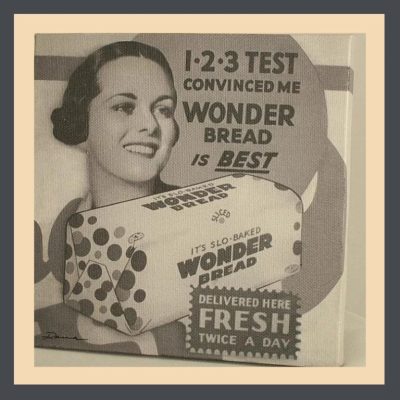 I adore old appliances & the antique toaster may be at the top of my list. I come by it honestly, being the granddaughter of a West Virginia baker. My grandfather decided to enter the business because he figured that it would be economically stable. People would always eat bread. It was a correct decision that benefited our family for several generations.
I adore old appliances & the antique toaster may be at the top of my list. I come by it honestly, being the granddaughter of a West Virginia baker. My grandfather decided to enter the business because he figured that it would be economically stable. People would always eat bread. It was a correct decision that benefited our family for several generations.
When I was a child growing up in Arizona, there was bread on the table every meal, never bought off the shelf, always purchased from the family bakery that had a stand at our neighborhood grocery.
Then I went to school & discovered Wonder Bread, served in our cafeteria. I was astonished & confused. You could squish it up in a ball like Play-Doh! I was accustomed to bread with body. You had to work a little to eat it.
My mother was appalled at this version of bread. In no way did she consider it the best nor even think of it as real bread.
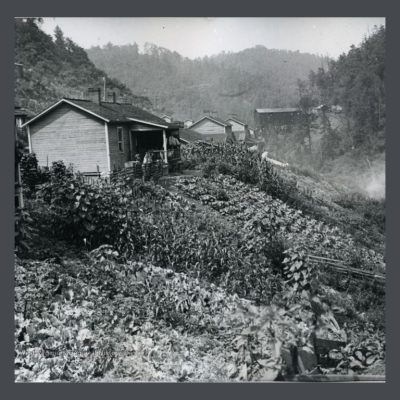 The specialty of my family’s bakery was salt rising bread. An Appalachian invention, I cannot but wonder if the recipe made its way from Sara Emmeline, my great-grandmother on the farm, to my grandmother, Gordie Elsie who left the farm as a young girl to become a woman of culture, to the bakery of her new husband. My cousin, whose father took over the bakery from my grandfather & who worked there for many years tells me that, “It was not a big seller unfortunately. Most of it was sold in the outlying small towns, mainly mining communities or communities with lots of old timers that come out of the West Virginia hollows on a Saturday morning to do their shopping in towns like Grant Town, or Fairview or Hundred. Fine folks with discerning tastes.”
The specialty of my family’s bakery was salt rising bread. An Appalachian invention, I cannot but wonder if the recipe made its way from Sara Emmeline, my great-grandmother on the farm, to my grandmother, Gordie Elsie who left the farm as a young girl to become a woman of culture, to the bakery of her new husband. My cousin, whose father took over the bakery from my grandfather & who worked there for many years tells me that, “It was not a big seller unfortunately. Most of it was sold in the outlying small towns, mainly mining communities or communities with lots of old timers that come out of the West Virginia hollows on a Saturday morning to do their shopping in towns like Grant Town, or Fairview or Hundred. Fine folks with discerning tastes.”
Not to be found in Arizona, my mother dreamed of salt rising & was sent loaves of it by the family. This humble bread, born of poverty & necessity, became a luxury for my mother because of its scarcity. Yeastless, it was very dense & chewy, like the most well-known sourdough & like its San Francisco counterpart, made exquisite, crunchy toast. We argued over who would get the heels.
LET’S BEGIN AT THE BEGINNING OF THE TALE OF THE ANTIQUE TOASTER
And jump around. I try to write chronologically, but cultural history is not always chronological. Different locations & classes changed their practices at differing times. I hope that you can follow along as I move from 1950 to 2000 B.C. to 1850 to 1910, then back to 1905, in my attempt to tell the tale of the antique toaster.
So here goes….
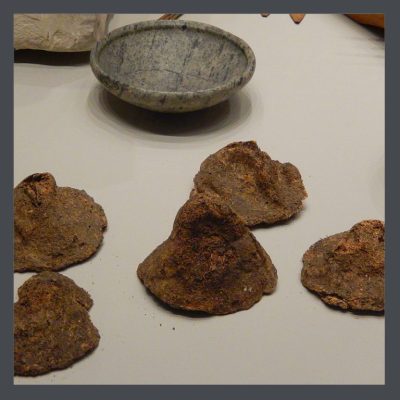 We have been eating grains since we were hunter/gathers. We learned to cook them, making gruel, which was easier to digest than the raw seeds, but rather messy. Then we discovered that baking grains into bread was a great deal handier. It grew mold more slowly. You could tote it around & it was tidy. You could eat it with your hands.
We have been eating grains since we were hunter/gathers. We learned to cook them, making gruel, which was easier to digest than the raw seeds, but rather messy. Then we discovered that baking grains into bread was a great deal handier. It grew mold more slowly. You could tote it around & it was tidy. You could eat it with your hands.
Bread is mostly sugars & starches making it the perfect candidate for caramelizing. Our affinity for crunch is hardwired into our species, as is our love of fat, so it’s not surprising that avocado toast is the food darling of the decade.
So, the obvious next next step was toasting the bread which made it even easier to digest. You could melt stuff on it. It was warm & comforting & it packed a nice caramelized crunch.
THE TOASTER AS PART OF OUR CHANGING CULTURE
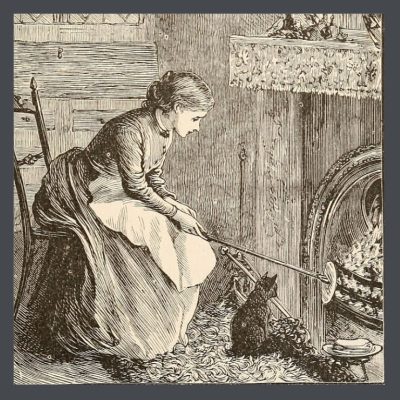 When we’re talking about bungalow toasters (That’s kinda what we do here, you know. We talk about bungalows.) we’re talking about pre-electricity for most of the original homeowners.
When we’re talking about bungalow toasters (That’s kinda what we do here, you know. We talk about bungalows.) we’re talking about pre-electricity for most of the original homeowners.
The earliest toasters, from the 1800’s, were forks made of iron with long handles so that you could stand back from the flames of the open fire. By the 1850’s, they began making the holders in a lighter metal & featured a mesh grill so that you could see the bread browning as it toasted.
With the decline of domestic help, as woman left working as maids to labor in the factories, appliances designed to ease the workload of the lady of the house became a necessity. Fortunately, the domestic technology was developing that could support this cultural change. For a more in-depth understanding of this glimpse into LIFE & TIMES, read this article.
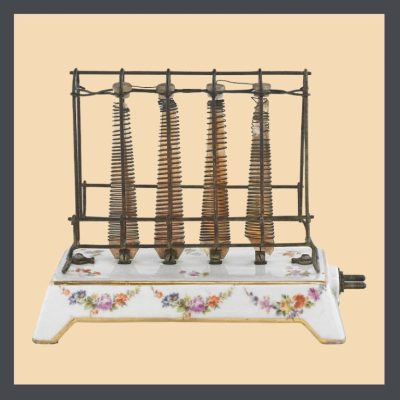 In 1905, the first filament, Nichrome, a non-magnetic alloy of nickel & chromium was discovered that could repeatedly generate heat to toast bread.
In 1905, the first filament, Nichrome, a non-magnetic alloy of nickel & chromium was discovered that could repeatedly generate heat to toast bread.
G.E. patented the first electric toaster, the D-12, for use in the home in 1909. It has four heating elements with the wire wrapped around forms made of heat-resistant mica. It sat on a porcelain base to insulate the table under it. As an option, you could get the base with a floral design. The toast was held in place by an exposed wire frame. Of course, it toasted only one side of the bread, giving you ample opportunity to burn your fingers!
However, electricity was not common in homes until the 1920’s. By 1925, only half the homes in America had electrical power & these were in larger metropolitan communities. It wasn’t until 1936, with FDR’s Rural Electrification Act, that millions of Americans, living outside of cities had access to electricity.
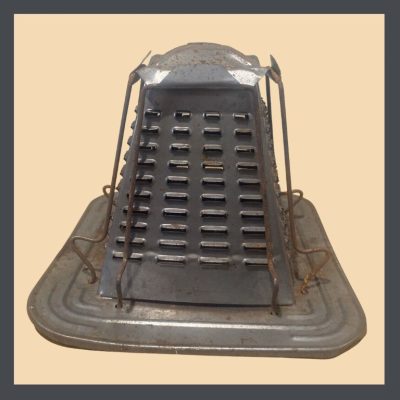 (Let’s do the Time Warp Again!) However, the Hare House, which was built in 1910, was lit by gas & most likely had a wood burning stove so Grace did not use the D-12 to make Alfred’s toast. One option was to use a cast iron skillet. She might have also used a tin contraption that sat on her wood burning stove. This flimsy piece of vented metal held the pieces of bread that you cut from the loaf & offered your fingers no protection against its heat. Tin rusts very easily when exposed to moisture so I can’t imagine that these lasted very long. I had one in my collection for my dreamed of restoration of the Hare House kitchen. I considered trying it out but it was too awful!
(Let’s do the Time Warp Again!) However, the Hare House, which was built in 1910, was lit by gas & most likely had a wood burning stove so Grace did not use the D-12 to make Alfred’s toast. One option was to use a cast iron skillet. She might have also used a tin contraption that sat on her wood burning stove. This flimsy piece of vented metal held the pieces of bread that you cut from the loaf & offered your fingers no protection against its heat. Tin rusts very easily when exposed to moisture so I can’t imagine that these lasted very long. I had one in my collection for my dreamed of restoration of the Hare House kitchen. I considered trying it out but it was too awful!
In 1913, the Coleman Electric Stove Company made a toaster that automatically turned the bread, saving fingers.
In 1914, Lloyd & Hazel Copeman, of the Copeman Electric Stove Company, were issued five patents for ways to “turn the toast” in their “automatic” toasters.
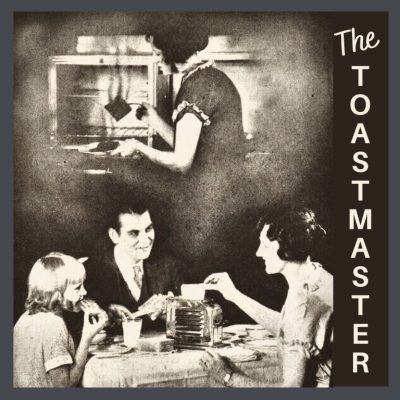 In 1919, the year that my mother was born, Charles Strite, a Minnesota mechanic invented the pop-up toaster, the Toastmaster, with both springs & a timer, for restaurant use. He later improved his design & sold it to the general public. You could even twist a little peg to set the toaster for the degree of toasting! Check out my toast videos to hear the timer loudly clicking away at differing speeds, depending on how dark you wanted your toast to be.
In 1919, the year that my mother was born, Charles Strite, a Minnesota mechanic invented the pop-up toaster, the Toastmaster, with both springs & a timer, for restaurant use. He later improved his design & sold it to the general public. You could even twist a little peg to set the toaster for the degree of toasting! Check out my toast videos to hear the timer loudly clicking away at differing speeds, depending on how dark you wanted your toast to be.
Around this time, manufacturers began adding a case to the units as a safety feature. With this newfangled toaster, Mom no longer had to be asphyxiated in the kitchen by smoke from burning toast, when she was preparing supper for the family.
A commonly voiced cliché in our baker family was, “The best thing since sliced bread!” In 1928, a bread slicing machine was invented & by 1930, The Continental Baking Company, which made that bread that fascinated me so as a child, Wonder Bread, began selling sliced bread which greatly increased the popularity of toasters. At the same time, assembly line production & easy credit made it possible for ordinary Americans to purchase many of these new consumer goods. A toaster on every table!
WON’T YOU BE MY SWEETHEART OF AN ANTIQUE TOASTER
A favorite toaster has been dubbed the “Sweetheart” because of its heart shape face, pendant “earrings” & its delicate, ornate casing. This Landers Frary & Clark toaster (Universal Model E9410, patented in 1929) was designed to attract the American housewife & was promoted as being an appealing addition to her kitchen decor. One of my readers remembers it fondly from his grandmother’s house, where, no, the children were allowed to watch, but not allowed to touch it.
Rather than march all the various styles of toasters across the page, I think I’d rather invite you to my Pinterest page where you can just gorge on pictures of them & also other small appliances. As one of my readers commented, “This is where the good stuff is!”
To see a variety of antique toasters in action, visit my YouTube playlist, ANTIQUE TOASTERS.
STAY IN THE BUNGALOW KNOW!!!
Sign up for our newsletter & receive our FREE E-book,
& receive our FREE E-book,
7 VITAL Things to Do Before You Hire a Contractor.



What a fun article, thank you. We use the little tin device that you mention in our vintage camp trailer, but ours looks a bit more substantial. We love it! It came from an elderly neighbor who lived her whole life in the same house. It fits over the gas burner and we like the toast it makes – it dries the bread out more than an electric toaster does, making it very crispy. You can make four slices at once and just have to flip them once during the toasting.
I’m so glad that you liked it & so sorry that it took me so long to respond to you!
Sounds yummy & is making me long for toast. Preferably salt rising!